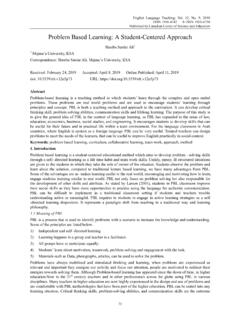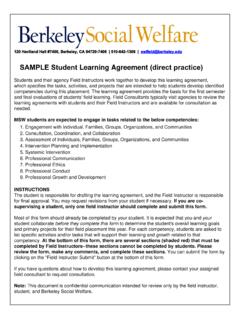Transcription of NURS 449 Preceptor Evaluation of Student - St. John Fisher ...
1 1 Clinical Evaluation Student Name: _____ Semester/Year: _____ Clinical Course: _____ Agency/Unit: _____ Date(s) of Absences (if applicable): _____ Make-up Date for Absences: _____ Mid-Term Clinical Evaluation : Meets Criteria: _____ At Risk: _____ (See comment page) Clinical Instructor Print Name: _____ Clinical Instructor Signature: _____ Date: _____ Student Print Name:_____ Student Signature: _____Date: _____ Clinical Site Visitor Print Name: _____ Clinical Site Visitor Signature: _____Date: _____ Final Clinical Evaluation : Meets Criteria: _____ Unsatisfactory: _____ (See comment page) Clinical Instructor Print Name: _____ Clinical Instructor Signature: _____Date: _____ Student Print Name:_____ Student Signature: _____Date: _____ Clinical Site Visitor Print Name: _____ Clinical Site Visitor Signature: _____Date: _____ 2 In order to PASS the clinical component of the course, the Student must demonstrate Satisfactory Clinical Performance by the Final Evaluation on ALL behavioral criteria in Bold Unsatisfactory Clinical Performance is receiving a Needs Improvement or Unsatisfactory (2 or 1) on ANY of the Behavioral Criteria in Bold by the Final Evaluation .
2 An Evaluation of Needs Improvement or Unsatisfactory (2 or 1) on the final Evaluation requires that the Student must repeat the course (theory and clinical) in order to successfully progress to the next clinical course. Evidence of unsafe or unprofessional behavior (see policy Unsafe Behavior Policy), requires that the Student repeat the course (theory and clinical) in order to successfully progress to the next clinical course. Grading Scale *Comment required 4 = Exceeds* 3 = Meets 2 = Needs Improvement* 1 = Unsatisfactory* N/A = No opportunity to Meet Behavioral Criteria 3 Complete the following for QSEN Core Competencies & Behavioral Criteria: Midterm (score) Final (score) Provides Patient- centered Care (Encompasses elements of Program Outcomes #1, 2, 3, 5, 8) Student Midterm Preceptor Midterm Student Final Preceptor Final Identifies opportunities for teaching health promotion, risk reduction and disease prevention; and incorporates patient education into the patient s plan of care.
3 Examples include: - Articulates patient education in the plan of care and/or changes to the plan of care Practices therapeutic communication in developing a trusting nurse-patient relationship. Examples include: - Demonstrates active listening, nonjudgemental attitude, empathy, and attention to nonverbal communication. - Uses direct, open, respectful and honest assertive communication techniques - Establishes professional boundaries in the care of patients - Identifies patient barriers to effective communication ( , sensory deficit, developmental, language, cultural, cognitive, and/or psychosocial barriers). Integrates holistic care and ethical principles that are sensitive and compassionate into to the care of patients and families. Demonstrates sensitivity to cultural influences on the individual s reactions to the illness.
4 Incorporates trauma informed care into the plan of care for patients as applicable Advocates for and empowers the patient/family as partners in the care process and supports their right to safe, compassionate, and holistic nursing care Clinical Instructor Section Summary Midterm: Clinical Instructor Section Summary Final: Complete the following for QSEN Core Competencies & Behavioral Criteria: Midterm (score) Final (score) 4 Exhibits Professionalism, Teamwork and Collaboration (Program Outcomes # 3, 4, 7) Student Midterm Preceptor Midterm Student Final Preceptor Final Demonstrates professional collaboration with members of the interdisciplinary health care team to improve patient outcomes. Examples include: - Identifies the roles and responsibilities for patient care team members ( , primary care provider, nurse, unlicensed assistive personnel, pharmacist, social worker, respiratory therapy, PT/OT, case manager, utilization review, hospitalist, residents, etc.)
5 - Utilizes the EMR to foster interdisciplinary communication for consistency in patient care and patient safety - Participates in interprofessional rounding Provides assistance to peers and the healthcare team to support teamwork and reduce or avoid errors. Examples include: - Provides mutual support - Demonstrates situational awareness - Delegates as appropriate to team members within their scope of practice - Models IMSAFE behaviors as outlined in TeamSTEPPS Communicates professionally with patients/families, healthcare team, and peers. Examples include: - Manages conflict effectively - Provides timely constructive feedback and advocacy when indicated to promote safe patient care - Participates in post-conferences and supports peers in civil discourse - Applies TeamSTEPPS communication tools to clinical situations as appropriate ( , CUS, Two Challenge Rule, Assertiveness, Call-Outs, SBAR, Check-Back, etc.)
6 Clinical Preceptor Section Summary Midterm: Clinical Preceptor Section Summary Final: 5 Complete the following for QSEN Core Competencies & Behavioral Criteria: Midterm (score) Final (score) Incorporates Evidence-Based Practice. (Program Outcomes # 3, 7) Student Midterm Preceptor Midterm Student Final Preceptor Final Integrates evidence-based practice in patient care delivery to support safe, quality patient care. Examples include: - Gathers credible, accurate, and current research/publications related to clinical practice topics that lead to patient safety and quality outcomes. - Actively seeks appropriate resources to answer clinical questions Integrates best current evidence with clinical expertise, clinical data, and patient/family preferences and values for delivery of optimal health care.
7 Examples include: - Incorporates patient preference in addition to evidenced-based information, clinical data, and clinical experience to inform decision-making - Applies essential patient/family information in the plan of care or teaching plan. - Demonstrates knowledge of and adheres to evidence-based standards of care/policies/protocols for the institution. Clinical Preceptor Section Summary Midterm: Clinical Preceptor Section Summary Final: Complete the following for QSEN Core Competencies & Behavioral Criteria: Midterm (score) Final (score) Applies Quality Improvement Methods (Program Outcomes # 2, 6, 7) Student Midterm Preceptor Midterm Student Final Preceptor Final Demonstrates awareness of and actively participates in the unit s quality improvement program. Examples include: - Handwashing - Bedside rounding - Alarm Fatigue - Noise reduction - Patient satisfaction - Infection prevention 6 - Falls reduction - Patient identification - Medication safety Identifies practice gaps and opportunities for improvement within the clinical site/organization.
8 Examples include: - Describes strategies for improving outcomes of care in the setting in which one is engaged in clinical practice - Analyzes the impact of factors such as access, cost, or team functioning on patient safety and quality improvement project efforts Clinical Preceptor Section Summary Midterm: Clinical Preceptor Section Summary Final: Complete the following for QSEN Core Competencies & Behavioral Criteria: Midterm (score) Final (score) Promotes confidentiality safety, and safe patient handling (Program Outcomes # 1, 3, 4, 7) Student Midterm Preceptor Midterm Student Final Preceptor Final Protects patient privacy and confidentiality in all communications (verbal, written, electronic). Examples include: - Adheres to HIPAA requirements and agency policies to maintain privacy and confidentiality of protected health information - Protects EMR access (closes the computer window and does not share login password) - Obtains EMR login to meet agency documentation requirements Uses proper PPE and adheres to infection control procedures and policies.
9 Demonstrates proper hand hygiene technique. Demonstrates competent use of medical devices in the care of patient. Examples include: - Completes orientation to unit equipment - Uses equipment per standards for safe patient assessment and monitoring 7 - Identifies personal gaps in knowledge and skill and seeks help - Uses proper body mechanics and assistive devices to promote safe patient handling and to avoid personal injury Adheres to Social Media and Technology Policy Demonstrates safe medication administration. Examples include: - Is prepared to discuss the patient s medication(s) in relation to the patient s diagnosis and lab findings as appropriate for the level of competency - Uses credible resources for researching medication information - Accurately records medication administration and monitors, reports, and documents the patient s response to the medication - Initially calculates correct dose, and IV rate of administration prior to then using pump technology, or other technology as a safety check - Identifies IV compatibility and medication dilution - Describes the indication, action, and side effects of medications - Provides appropriate patient education on medications and medication safety to the patient/family Clinical Preceptor Section Summary Midterm.
10 Clinical Preceptor Section Summary Final: Complete the following for QSEN Core Competencies & Behavioral Criteria: Midterm (score) Final (score) Applies the Nursing Process: Student Midterm Preceptor Midterm Student Final Preceptor Final Assesses, manages and anticipates physical, psychological, social and spiritual symptoms/issues and or complications related to a disease process Competently applies each step of the nursing process from assessment to Evaluation in patient care. Assessment. Examples Include: - Demonstrates competency with physical assessments 8 - Collects patient data using a variety of sources ( , patient/family interview, EMR, health care team) - Documents patient care according to unit standards and timeframe Diagnose. Examples Include: - Identifies priority patient problems - Selects appropriate nursing diagnoses according to patient presentation and assessment data Plan.







